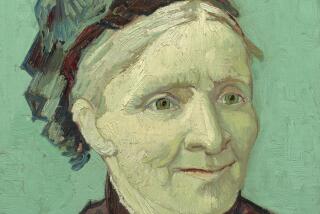ART REVIEW : Photos in Platinum That Teach and Entertain
- Share via
“Recent Photography in Platinum: Photographs From the Platypus Group,” at Loyola Marymount’s Laband Gallery (to Aug. 27), is a small show of works that run from the inspired to the barely mediocre. Yet the show scores on two major counts. It adheres to the notion that local show spaces should keynote local artists. Further, it teaches while it entertains.
The Platypus Group is a 15-member association of photographers loosely based in Van Nuys and knit together by their use of platinum printing. What’s that? you ask. We’ve all heard words like silver gelatin print , bromide print and, more rarely, platinum print. As the instructive exhibition handouts clarify, these terms refer to the chemicals used to coat photographic paper and render it light sensitive. Each has its own properties that produce subtle differences in the acuity and tonality of the black-and-white image: Bromide prints tend toward cooler tones, platinum toward warmer tones, less contrast and subdued detail.
These properties attracted fine-art photographers to platinum printing in the late 1800s when photography, like painting and literature, was moving away from the glossy staging of Victorian tastes and toward naturalism. Appreciated for its atmospheric quality and its ability to duplicate the way reality appears to the eye, platinum printing was used widely until the late 1930s when the cost and scarcity of chemicals made commercial platinum photo paper obsolete.
About 20 years ago, contemporary photographers rediscovered its special formal properties and began making platinum-coated paper in their studios.
The softened contours of the technique give a romantic touch to the landscapes, still lifes, nudes, portraits and interiors on view. Landscapes dominate the show and here John Pietrzak’s “Tecapoa Hot Springs” and Nitza Luna’s exotic views of dense vegetation and reflective pools excel. A stunning photo by Marshall Sowder frames a bending nude in the coiling crook of a granite cave and several skillfully lit studio portraits by Gordon Mark are every bit as sensual.
Robert Sullivan shows “Claudia,” a weird alabaster nude with the doughy appeal of a Balthus preteen. The platinum print’s capacity to neutralize extremes of light tames sharp interior shadows in Fred Byrum’s lone, tattered chair and optimizes the strong back lighting in Dan Burkholder’s photo of cloaked Muslim women gazing out to sea.
More to Read
The biggest entertainment stories
Get our big stories about Hollywood, film, television, music, arts, culture and more right in your inbox as soon as they publish.
You may occasionally receive promotional content from the Los Angeles Times.










